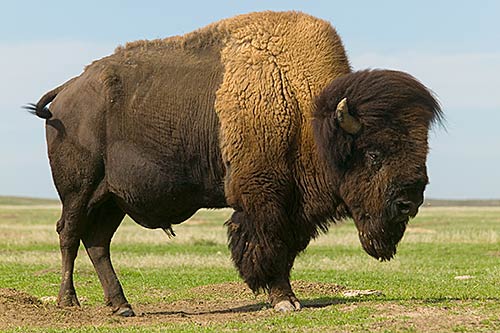The American bison (Bison bison) is a North American buffalo that is typically found in the United States and the northwestern Canada. It is likely to graze on the grasslands of northern Mexico. It is arguably the largest living land mammal in the United States. In the 19th century humans have hunted bison to almost extinction. Turns out many bisons are now limited to certain national parks or reserves. IUCN has listed it Near Threatened species.
American Bison Facts
Anatomy
- During winter, American bisons are mainly recognized by their dark brown shaggy coat. The color of the coat fades in summer.
- Males are larger as compared to females.
- The head-body length of the adult bison averages 95.2–125.2 in (242–318 cm) in males while females average 68.1–109.4 in (173–278 cm). The tail further adds 30 to 91 cm (12 to 36 in).
- They stand 152 to 186 cm (60 to 73 in) tall at the shoulder.
- Bisons are the heaviest land mammal in north america. Male bisons average 1,199–1,999.5 lb (544–907 kg) and females weigh up to 701–1,201 lb (318–545 kg).
Habitat
- American bisons are likely to make homes in many different habitats such as prairies, plains, semiopen grasslands, scrublands, boreal forests, sagebrush, and semiarid lands.
- In the southern regions, they breed in the short grass parklands and prairies as well as on the foothills of Rocky Mountains.
- Some of the isolated population is also found in the wooded habitats. They are thought to graze in hilly areas especially where the slope is not too steep.
- Nevertheless they have adapted to living at high altitudes for up to 8,000 feet. In Utah, they live in Henry Mountains at an elevation of about 10,000 feet.

Behavior & Diet
- American bisons are migratory animals and they travel every day to search food. During summer they are likely to travel more than in winter.
- Bisons living in the montane valley travel as much as 3.2 kilometers a day.
- They are thought to rely almost exclusively on sedges and grasses. Sedges make up 79–96% of the bison’s diet.
- They spend two hours each day on grazing and chewing grasses.
- Male bisons leave the herd when they come of age (3 years). Females along with their offspring stay in a herd.
- The female alone contributes toward rearing the young.
- Bisons are able to jump 6 ft (1.8 m) high vertically.
- There are 30 animals in a group. When they migrate bisons cover 200 km.
- They are quite fast when agitated. American bisons run at a speed of 35-40 mph (56–64 km/h).
Reproductive Biology
- The breeding occurs in August and September.
- The gestation period lasts about 285 days.
- They begin to breed when they are 3 years of age. Male bison is known as bull.
- In the wild, the average lifespan of American bisons is 15 years while the captive animal lives up to 25 years.
- They become independent in 210 – 365 days.
- The female gives birth to one young on an average but twins are also born.
- Calves show light brown coat at birth but the color goes brighter as they grow older.
- The total population of American bisons is 15,000 remaining in the wild. However in private parks or reserves there are 500,000 bisons in total.
- Wolves seem to be the only predator of American bisons.






Leave a Reply